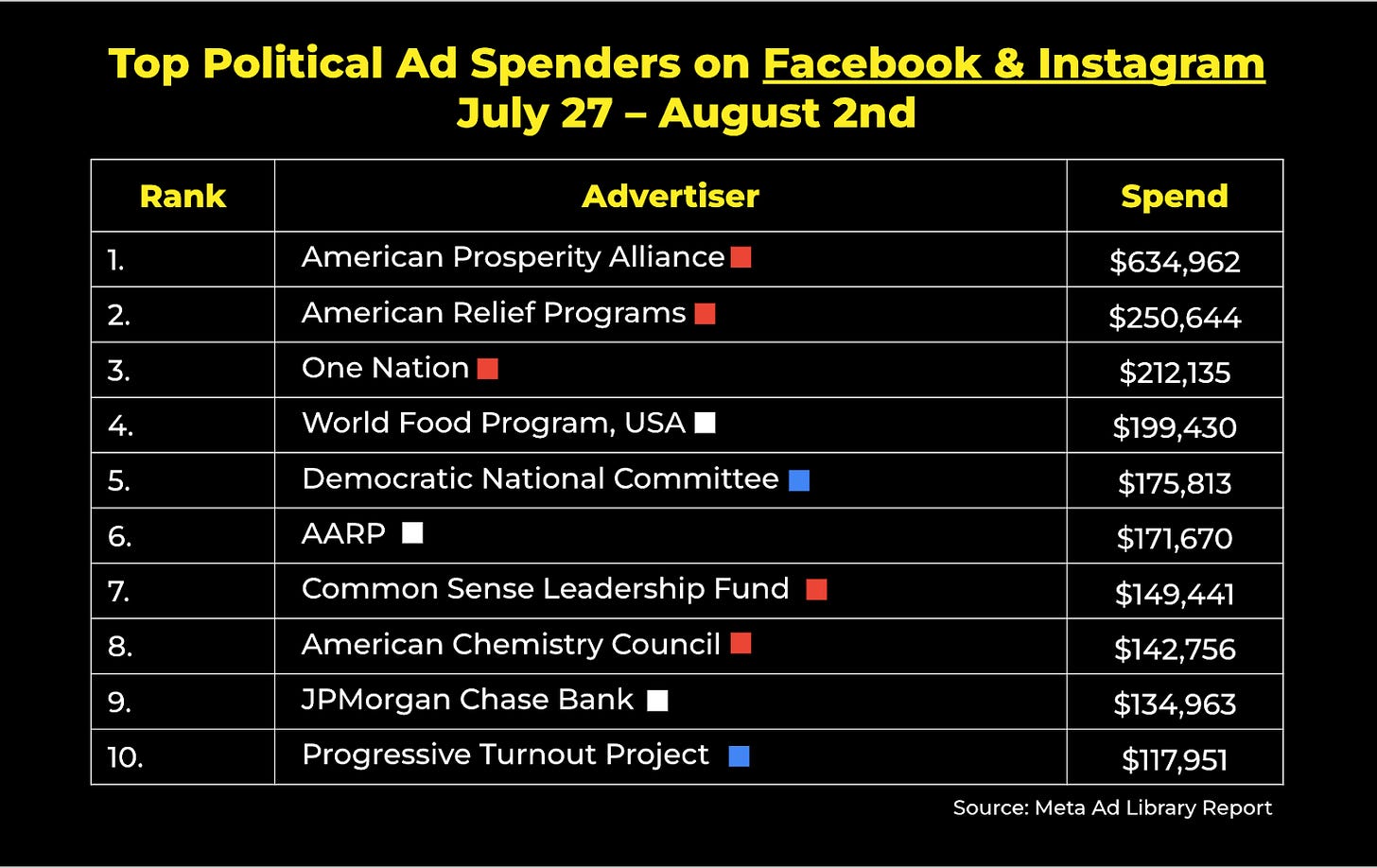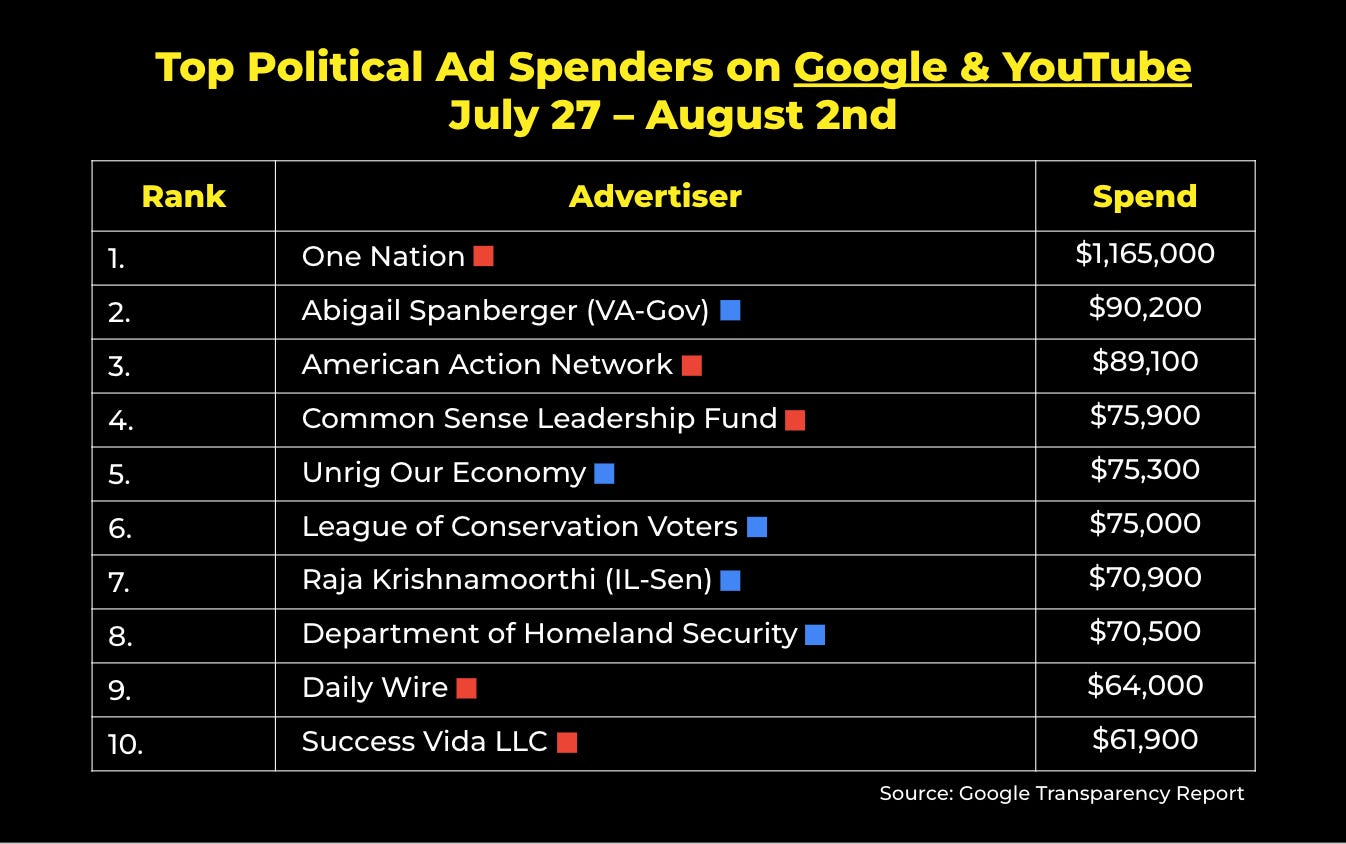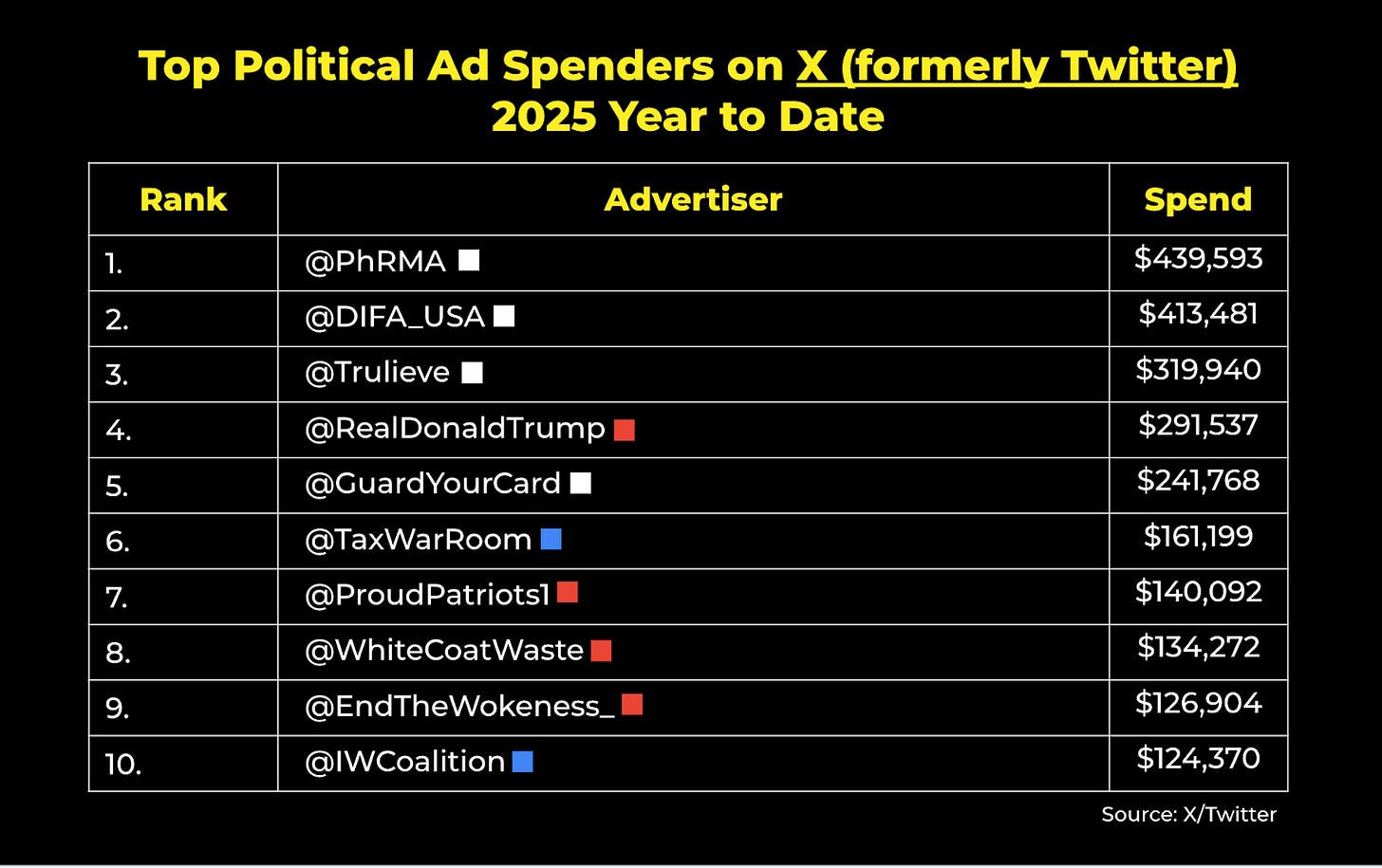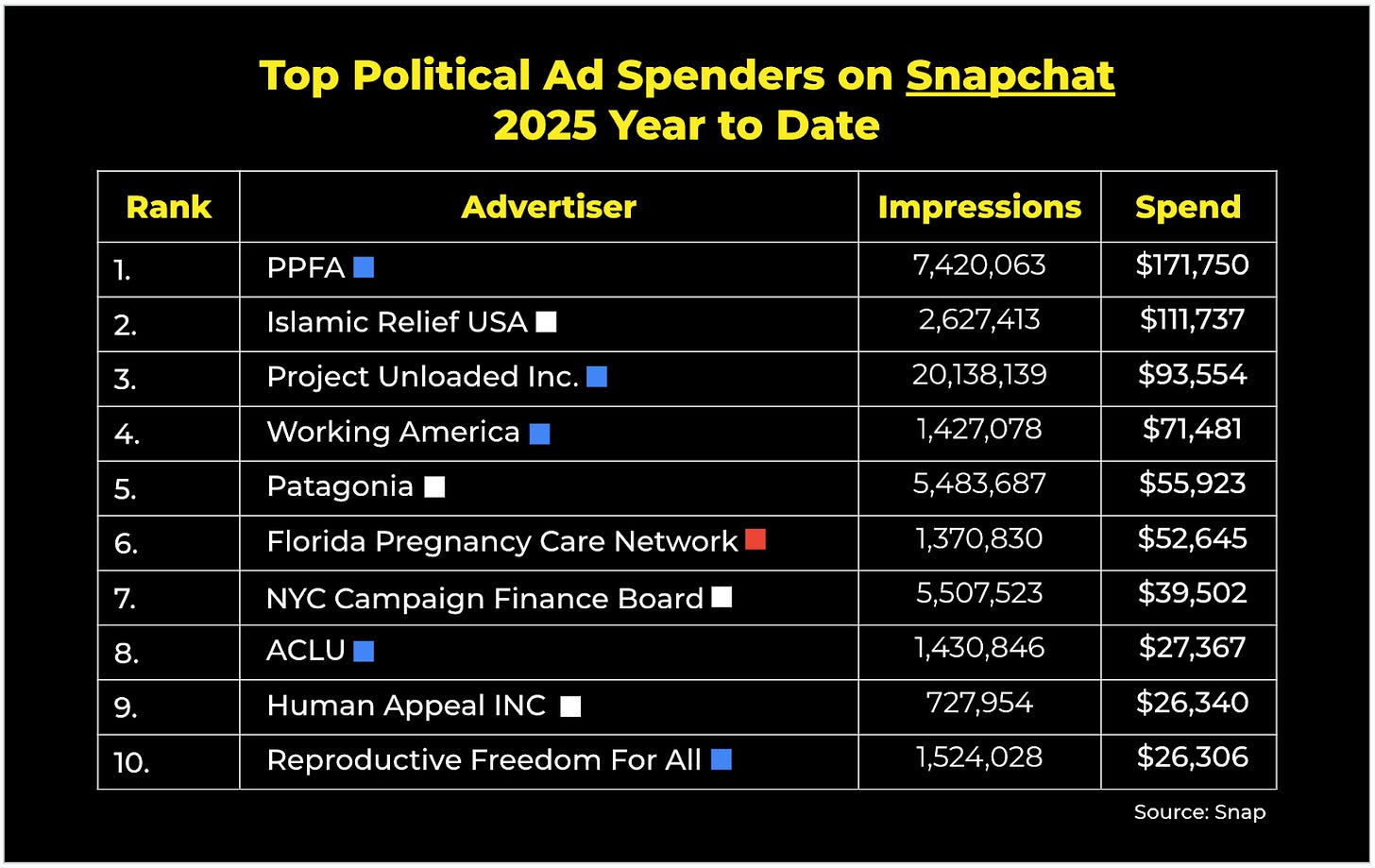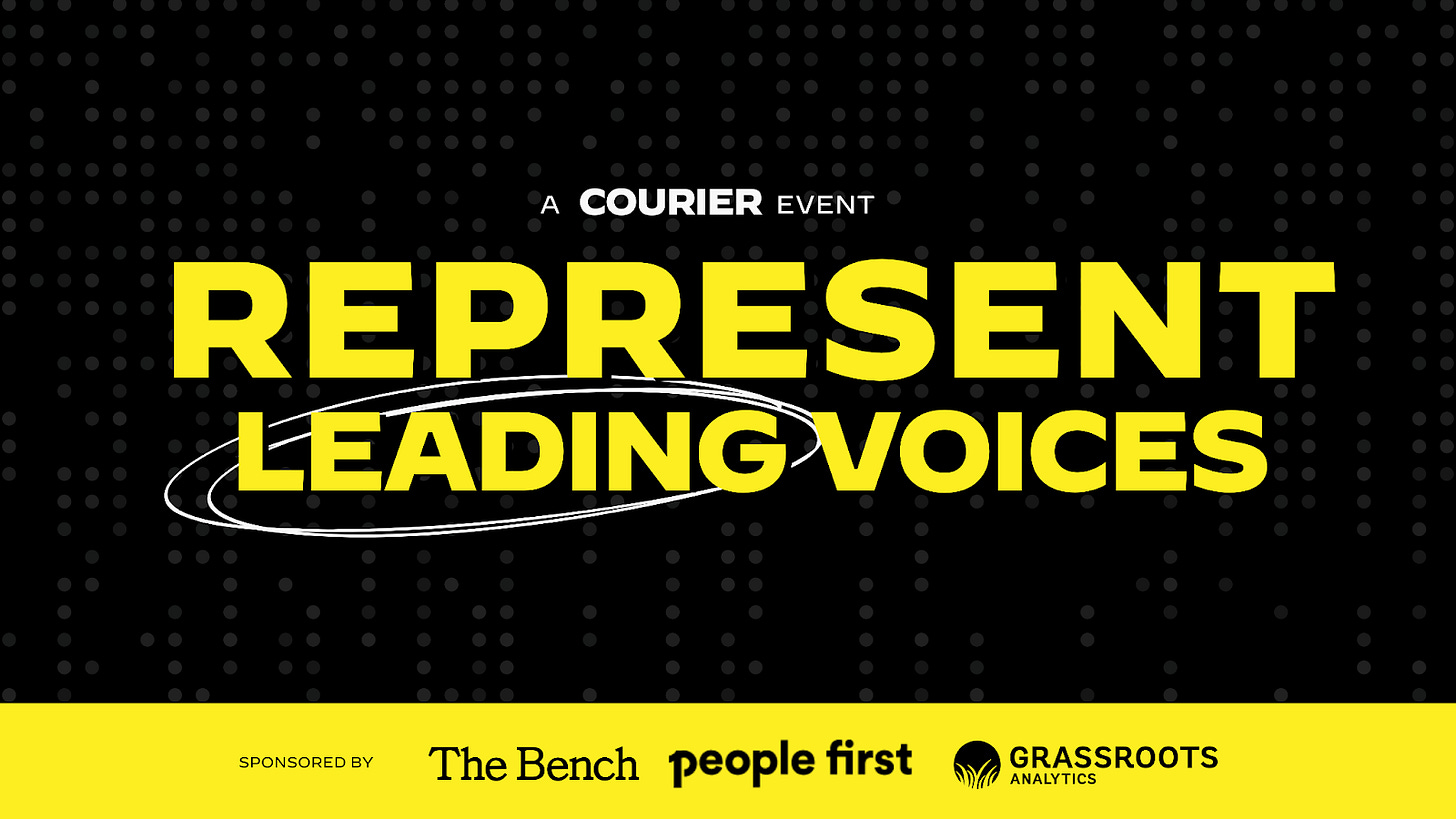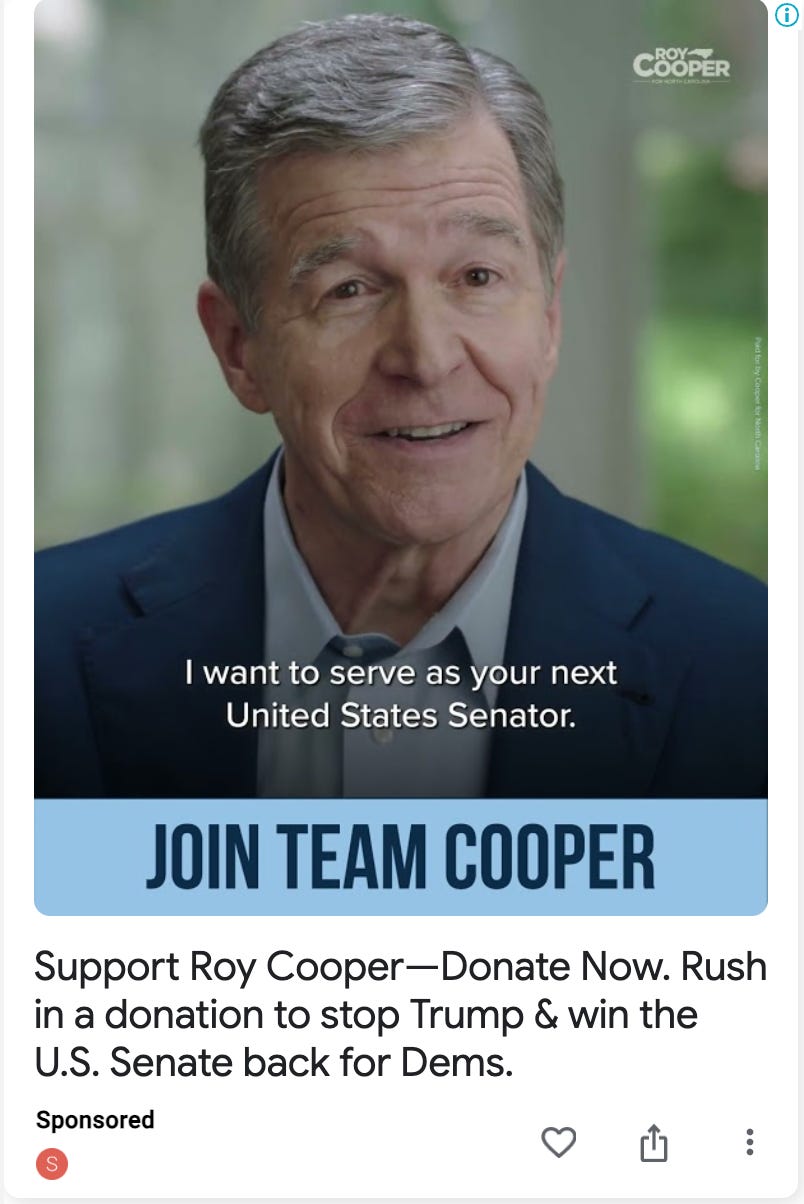How Roy Cooper’s Senate Launch Played Out Online
Also inside: GOP-aligned IEs are spending big on Trump’s big Medicaid cuts, why Dem unfavorables (probably) aren’t as bad as you think, and more
Hi folks 👋 I’m Brian O’Grady, your guest author for the next few weeks. I’m a digital strategist with a background in ads. Before becoming a freelancer, I did search engine marketing back in 2012 for the Obama re-elect and then worked at a handful of agencies, including the shop I co-founded, Clarify Agency.
This week, I take a deep dive into Governor Roy Cooper’s record-breaking Senate campaign launch. More on that below, but first…
Digital ad spending, by the numbers:
FWIW, U.S. political advertisers spent about $9.7 million on Facebook and Instagram ads last week. Here were the top ten spenders nationwide:
Trump’s Big Beautiful Bill is unpopular, and the GOP seems to be finally taking notice. One Nation, an American Crossroads IE that spends primarily to boost Senate Republicans, reportedly spent close to $200 million in 2020, including about $4mm from 2018 to present on Meta. Now, they’re back on the charts in 2025, giving air cover to Republican senators for supporting Trump’s tax bill, and attacking Jon Ossoff for opposing it.
Meanwhile, political advertisers spent just over $3 million on Google and YouTube ads last week. These were the top ten spenders nationwide:
Also on Trump’s OBBB, Unrig Our Economy and League of Conservation Voters broke into the top tier this week, attacking Republican House members for voting for Trump’s tax bill, with specific hits on Medicaid cuts. This appears to be one of the first times progressive-side IEs have made a significant attempt to hang the cuts around Republicans’ necks – but it’s just a drop in the bucket compared to what groups on the right are spending.
Speaking of… One Nation’s Google ad messaging mirrors their buy on Meta, which we discussed above. Worth noting: About half their $1.1 million spend was on behalf of (presumably safe) Texas Sen. John Cornyn.
On X (formerly Twitter), political advertisers in the U.S. have spent around $5.9 million on ads in 2025. According to X’s political ad disclosure, here are the top spenders year to date:
@PhRMA is up with some helpful new ads of regular folks like you and me doing their own research into why drug costs are so high.
…and lastly, on Snapchat, political advertisers in the U.S. have spent around $1.1 million on ads in 2025. Here are the top spenders year to date:
Join COURIER in NYC on September 10 for REPRESENT, a live event spotlighting the rising class of political leaders and digital creators. Speakers will include Deja Foxx, Anderson Clayton, Suzanne Lambert, and Nicole Dunger — with more to be announced in the coming weeks.
The evening will explore how power, media, and engaging voters are being redefined in America today. There will be discussions around how to create media-powered movements, how campaigns effectively partner with content creators, and the new digital-first tactics + strategies needed to win.
Conversations will be followed by a networking reception, with drinks and light bites provided. Space is extremely limited, so RSVP now to secure your spot and explore VIP options for exclusive Q&A access, reserved seating, and COURIER merch.
How Roy Cooper’s Senate Launch Played Out Online
North Carolina represents one of the few pickup opportunities for Dems in 2026, and now they have a new star to potentially get them there: Gov. Roy Cooper, who wrapped up his governorship in 2024, announced his run for US Senate on July 28th.
Cooper, who’s consistently won at the statewide level going back to 2000, could very well break Dems’ losing streak for that Senate seat. Today, we’re looking at what the campaign’s digital launch looked like (and spoilers… it was pretty prolific).
Ads
On the ads side, the campaign has spent a little over $43,000 on Google. The majority of that spend went to search ads (which typically the best channel for ROAS during high-volume moments like launches).
Cooper’s team also ran a handful of video ads on Google – short, direct-to-camera fundraising appeals – amounting to $5,000 in ad spend. This particular ad unit can be difficult to optimize, and while the campaign had paused most of these, at least one is still active at the time of writing, indicating they’re seeing some decent fundraising results.
On Facebook, the campaign is running a mix of short videos and image ads appealing for donations. They’ve spent about $68,000 to date, and, it bears noting, seem to be churning through new creative quickly.
Video
On the organic side, the campaign has a small number of video assets they’ve been running across multiple channels. Chief among these is the announcement video. It’s the most-viewed campaign asset on every channel, clocking around 386,000 views on Facebook, 447,000 views on Instagram, 4.4 million views on X, and a stately 26,000 views on YouTube.
If you haven’t seen the launch video, it’s worth a watch. The opening line, “It wasn’t always this hard,” is a striking example of a messaging technique I love and wish more progressives would make use of: appealing to a psychologically conservative value on behalf of a liberal goal. In this case, the value is nostalgia for a time when things were easier, and the goal is, well, change. Cooper also names a villain – “the biggest corporations and the richest Americans” who “have grabbed unimaginable wealth at your expense.”
There are some snoozy moments that don’t really work for online audiences – principals listing policy achievements, for example, tend to trigger people to tune out or hit the skip button. But “cutting health care for the poor … just to give tax breaks to billionaires” is, frankly, refreshing language for these kinds of videos.
The campaign also put up something like a teaser video shortly before the announcement. It’s six seconds long (not counting the five seconds of end card). Cooper simply walks into an empty frame, sits down, and says to someone off-camera, “Alright, are we ready to roll?”
It’s disarming and effective. These kinds of unscripted, naturalistic moments are really hard to capture. They’re also hard currency for social these days, where authenticity is key.
There’s another social-ready video of Cooper thanking small-dollar donors on the phone. Neither of the videos is running huge numbers, with about 650,000 views between them across platforms. But they roll up to a strategy, presenting Cooper as approachable, humble, and a little funny.
Email
Finally, the digital team’s been running an aggressive email program, per the Archive of Political Emails, with 2-3 emails per day for the first week, tapering to once a day. (This doesn’t include fundraising emails sent by Boston mayoral candidate Josh Kraft that used Cooper’s name without permission.)
The content is a grab bag. There are direct appeals from the governor: “Humbled to have your support, and sincerely asking for your endorsement.” There are sober, policy-driven petition asks, like this email on the Voting Rights Act.
And of course, there are a couple of examples of what I sometimes call the Festival of Formatting (caps, italics, highlighter, and red text). These are the kinds of borderline-hysterical, overly familiar emails that everyone hates but are allegedly effective.
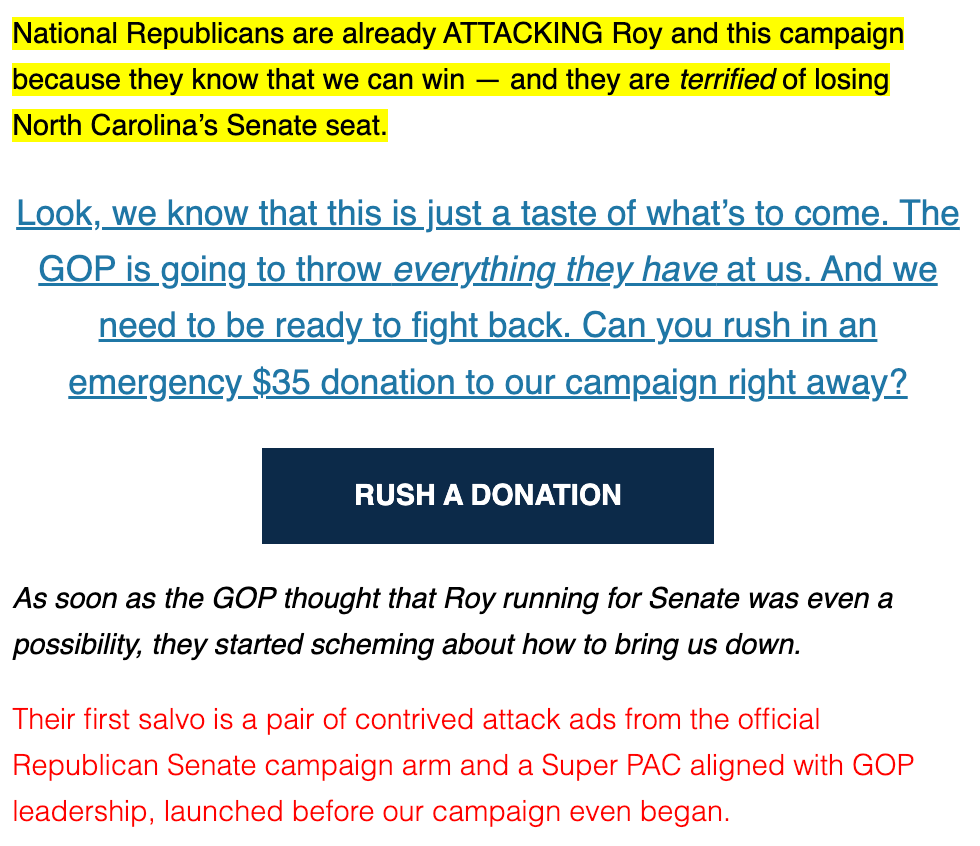
Fundraising
The launch yielded huge fundraising totals: The campaign reportedly raised $3.4 million in the first 24 hours, breaking the $2.5 million record set by Amy McGrath’s 2019 campaign launch.
Are fundraising totals the only thing being broken here? The launch has been a fairly paint-by-numbers affair. Email, ads, digital video – tactically, none of these look strikingly different from what a Senate campaign’s digital launch looked like ten years ago.
At the same time, executing the existing playbook might be boring, but it’s a playbook for a reason. And the digital team here did it without missing a beat. Roy Cooper has great name ID. He closed his gubernatorial term with strong approval ratings. And he’s an experienced campaigner. The fundamentals are strong. Will that be enough? We’ll see!
Are you a mission-aligned company or organization?
COURIER would love to partner with you and amplify your work to our engaged audience of 190,000+ policy influencers and high-information active news consumers. Send a note to advertising@couriernewsroom.com for more.
More from around the internet:
The WSJ published a new poll indicating the Democratic Party’s unfavorables are at an all-time high. At Strength in Numbers, G. Elliott Morris and Mary Radcliffe make the case that it’s probably premature to panic.
Stanford political scientist Adam Bonica published a detailed investigation into the network of PACs associated with Mothership Strategies, calling the relationship “blatant self-dealing.”
“No one wants to go to a party that sucks.” Run For Something’s Amanda Litman spoke with Intelligencer about takeaways from Zohran Mamdani’s win.
Meet Michael B. Fernández, the billionaire former Republican funding the “Deporting Immigrants is Cruel” ads in Florida. He’s targeting the Cuban-born Republicans from the Florida delegation for accelerating the degradation of American democracy.
That’s it for FWIW this week. This email was sent to 24,518 readers. If you enjoy reading this newsletter each week, would you mind sharing it on X/Twitter, Threads, or Bluesky? Have a tip, idea, or feedback? Reply directly to this email.




